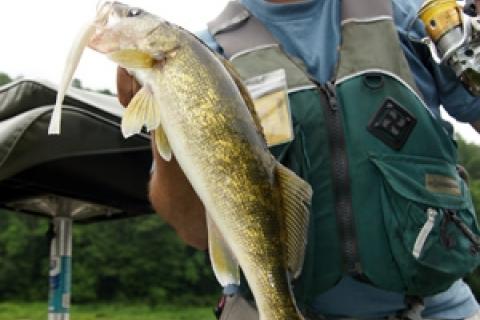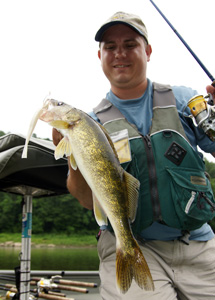
 Walleyes are river fish. Some of the best fishing for marble-eyes happens on river systems, particularly during the cold water periods of early spring and late fall. During those times, walleyes concentrate in select areas, driven by the need to spawn (early spring) and security (slackwater areas of late fall though winter).
Walleyes are river fish. Some of the best fishing for marble-eyes happens on river systems, particularly during the cold water periods of early spring and late fall. During those times, walleyes concentrate in select areas, driven by the need to spawn (early spring) and security (slackwater areas of late fall though winter).
Finding walleyes from late spring through early fall can be more challenging, especially on free-flowing rivers that don't have man-made structures like wingdams and navigation dams to attract fish.
A consistently productive location of walleyes during the warm months is the tailout area of large river pools. This is the area where the pool shallows up, increasing in speed before it dumps into the riffle and/or run below. With the arrival of summer, such places often feature clumps of milfoil and eelgrass, providing additional cover. Early and late in the day, and during rainy/cloudy days, it's common to catch river walleyes in a foot or two of water from such spots. These are aggressive feeding-fish, fighting hard and sloshing around on the surface when hooked.
A top tactic for catching these fish is to use a soft jerkbait like Bass Pro Shops' Shadee Shad. Rig a 4- or 5-inch bait on a 2/0 or 3/0 worm hook. Ones the incorporate a light cylindrical weight to the hook shank — such as Mustad's Ultra Point Plus weighted hook — work well for this, as the weight acts as a keel, toning down the action of the bait, which walleyes seem to prefer.
Hold the boat above the shallow tailout zone and make long casts quartering downriver. Allow the bait to swing down with the current as you slowly twitch it back upriver. Once the bait's swing is complete, and it's hanging straight downriver, permit it to hang in the current a few seconds, which often triggers a strike. Then continue slowly twitching the bait back to the boat.
River walleyes like to follow a bait, so let it hang for a second or two before pulling it out of the water. This tactic works best in clear to slightly stained water.
- 4053 views

